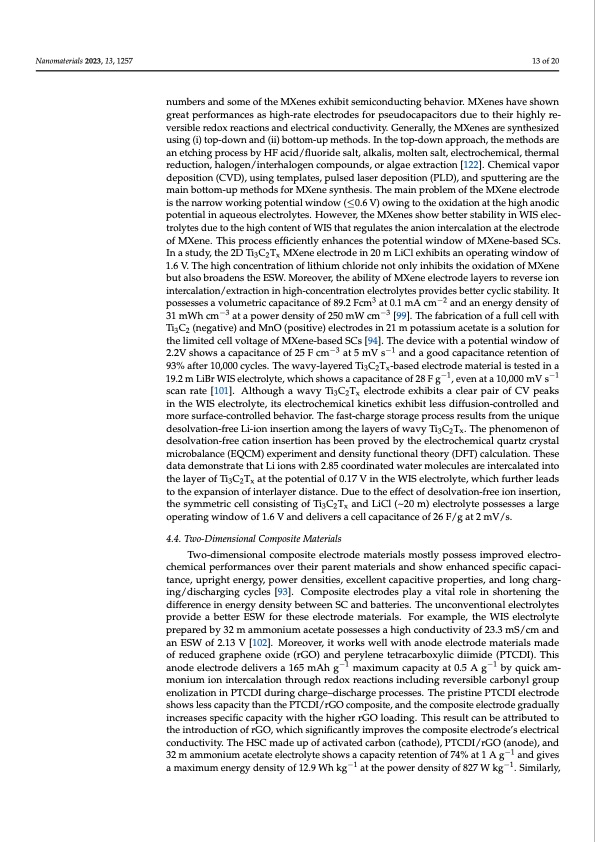
PDF Publication Title:
Text from PDF Page: 013
Nanomaterials 2023, 13, 1257 13 of 20 numbers and some of the MXenes exhibit semiconducting behavior. MXenes have shown great performances as high-rate electrodes for pseudocapacitors due to their highly re- versible redox reactions and electrical conductivity. Generally, the MXenes are synthesized using (i) top-down and (ii) bottom-up methods. In the top-down approach, the methods are an etching process by HF acid/fluoride salt, alkalis, molten salt, electrochemical, thermal reduction, halogen/interhalogen compounds, or algae extraction [122]. Chemical vapor deposition (CVD), using templates, pulsed laser deposition (PLD), and sputtering are the main bottom-up methods for MXene synthesis. The main problem of the MXene electrode is the narrow working potential window (≤0.6 V) owing to the oxidation at the high anodic potential in aqueous electrolytes. However, the MXenes show better stability in WIS elec- trolytes due to the high content of WIS that regulates the anion intercalation at the electrode of MXene. This process efficiently enhances the potential window of MXene-based SCs. In a study, the 2D Ti3C2Tx MXene electrode in 20 m LiCl exhibits an operating window of 1.6 V. The high concentration of lithium chloride not only inhibits the oxidation of MXene but also broadens the ESW. Moreover, the ability of MXene electrode layers to reverse ion intercalation/extraction in high-concentration electrolytes provides better cyclic stability. It possesses a volumetric capacitance of 89.2 Fcm3 at 0.1 mA cm−2 and an energy density of 31 mWh cm−3 at a power density of 250 mW cm−3 [99]. The fabrication of a full cell with Ti3C2 (negative) and MnO (positive) electrodes in 21 m potassium acetate is a solution for the limited cell voltage of MXene-based SCs [94]. The device with a potential window of 2.2V shows a capacitance of 25 F cm−3 at 5 mV s−1 and a good capacitance retention of 93% after 10,000 cycles. The wavy-layered Ti3C2Tx-based electrode material is tested in a 19.2 m LiBr WIS electrolyte, which shows a capacitance of 28 F g−1, even at a 10,000 mV s−1 scan rate [101]. Although a wavy Ti3C2Tx electrode exhibits a clear pair of CV peaks in the WIS electrolyte, its electrochemical kinetics exhibit less diffusion-controlled and more surface-controlled behavior. The fast-charge storage process results from the unique desolvation-free Li-ion insertion among the layers of wavy Ti3C2Tx. The phenomenon of desolvation-free cation insertion has been proved by the electrochemical quartz crystal microbalance (EQCM) experiment and density functional theory (DFT) calculation. These data demonstrate that Li ions with 2.85 coordinated water molecules are intercalated into the layer of Ti3C2Tx at the potential of 0.17 V in the WIS electrolyte, which further leads to the expansion of interlayer distance. Due to the effect of desolvation-free ion insertion, the symmetric cell consisting of Ti3C2Tx and LiCl (~20 m) electrolyte possesses a large operating window of 1.6 V and delivers a cell capacitance of 26 F/g at 2 mV/s. 4.4. Two-Dimensional Composite Materials Two-dimensional composite electrode materials mostly possess improved electro- chemical performances over their parent materials and show enhanced specific capaci- tance, upright energy, power densities, excellent capacitive properties, and long charg- ing/discharging cycles [93]. Composite electrodes play a vital role in shortening the difference in energy density between SC and batteries. The unconventional electrolytes provide a better ESW for these electrode materials. For example, the WIS electrolyte prepared by 32 m ammonium acetate possesses a high conductivity of 23.3 mS/cm and an ESW of 2.13 V [102]. Moreover, it works well with anode electrode materials made of reduced graphene oxide (rGO) and perylene tetracarboxylic diimide (PTCDI). This anode electrode delivers a 165 mAh g−1 maximum capacity at 0.5 A g−1 by quick am- monium ion intercalation through redox reactions including reversible carbonyl group enolization in PTCDI during charge–discharge processes. The pristine PTCDI electrode shows less capacity than the PTCDI/rGO composite, and the composite electrode gradually increases specific capacity with the higher rGO loading. This result can be attributed to the introduction of rGO, which significantly improves the composite electrode’s electrical conductivity. The HSC made up of activated carbon (cathode), PTCDI/rGO (anode), and 32 m ammonium acetate electrolyte shows a capacity retention of 74% at 1 A g−1 and gives a maximum energy density of 12.9 Wh kg−1 at the power density of 827 W kg−1. Similarly,PDF Image | Water-in-Salt Eutectic Solvent-Based Liquid Electrolytes

PDF Search Title:
Water-in-Salt Eutectic Solvent-Based Liquid ElectrolytesOriginal File Name Searched:
nanomaterials-13-01257.pdfDIY PDF Search: Google It | Yahoo | Bing
Salgenx Redox Flow Battery Technology: Power up your energy storage game with Salgenx Salt Water Battery. With its advanced technology, the flow battery provides reliable, scalable, and sustainable energy storage for utility-scale projects. Upgrade to a Salgenx flow battery today and take control of your energy future.
| CONTACT TEL: 608-238-6001 Email: greg@infinityturbine.com | RSS | AMP |